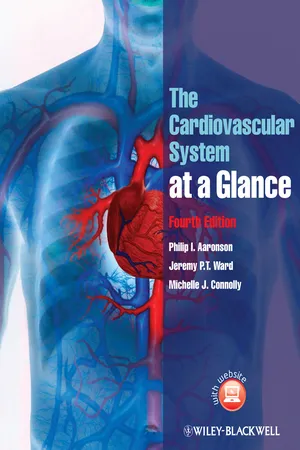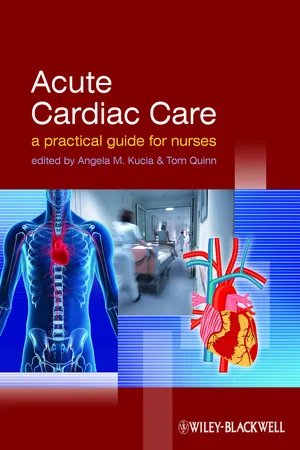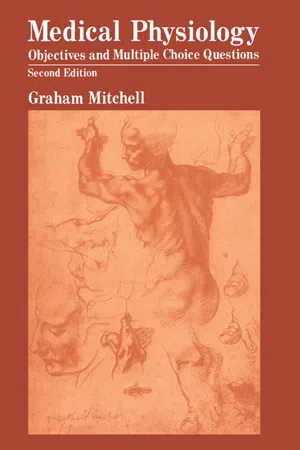Cardiac Cycle
The cardiac cycle refers to the sequence of events that occur during one heartbeat. It includes the contraction (systole) and relaxation (diastole) of the heart chambers, leading to the pumping of blood throughout the body. The cardiac cycle is essential for maintaining blood circulation and delivering oxygen and nutrients to tissues.
7 Key excerpts on "Cardiac Cycle"
- eBook - ePub
- Philip I. Aaronson, Jeremy P. T. Ward, Michelle J. Connolly(Authors)
- 2012(Publication Date)
- Wiley-Blackwell(Publisher)
...16 Cardiac Cycle The Cardiac Cycle is the sequence of events that occurs during a heart beat (Figure 16a). The amount of blood ejected by the ventricle in this process is the stroke volume (SV), ∼70 mL, and cardiac output is the volume ejected per minute (SV × heart rate). Towards the end of diastole (G) all chambers of the heart are relaxed. The valves between the atria and ventricles are open (AV valves : right, tricuspid ; left, mitral), because atrial pressure remains slightly greater than ventricular pressure until the ventricles are fully distended. The pulmonary and aortic (semilunar) outflow valves are closed, as pulmonary artery and aortic pressure are greater than the respective ventricular pressures. The cycle begins when the sinoatrial node initiates the heart beat (see Chapter 11). Atrial Systole (A) Contraction of the atria completes ventricular filling. At rest, the atria contribute less than 20% of ventricular volume, but this proportion increases with heart rate, as diastole shortens and there is less time for ventricular filling. There are no valves between the veins and atria, and some blood regurgitates into the veins. The a wave of atrial and venous pressure traces reflects atrial systole. Ventricular volume after filling is known as end-diastolic volume (EDV), and is ∼120–140 mL. The equivalent pressure (end-diastolic pressure, EDP) is <10 mmHg, and is higher in the left ventricle than in the right due to the more muscular and therefore stiffer left ventricular wall. EDV is an important determinant of the strength of the subsequent contraction (Starling’s law; see Chapter 17). Atrial depolarization causes the P wave of the ECG. Ventricular Systole Ventricular contraction causes a sharp rise in ventricular pressure, and the atrioventricular (AV) valves close once this exceeds atrial pressure. Closure of the AV valves causes the first heart sound (S 1 ; see below). Ventricular depolarization is associated with the QRS complex of the ECG...
- eBook - ePub
Fundamentals of Anatomy and Physiology
For Nursing and Healthcare Students
- Ian Peate, Suzanne Evans, Ian Peate, Suzanne Evans(Authors)
- 2020(Publication Date)
- Wiley-Blackwell(Publisher)
...The Cardiac Cycle can be broken down into a series of steps that are detailed below. The flow of blood in the heart and the circulatory system is always from a point of higher pressure to a point of lower pressure. Figure 9.16 The Cardiac Cycle. Source: Tortora and Derrickson (2009). Reproduced with permission of John Wiley & Sons. The Cardiac Cycle is usually divided into five phases: A period of ventricular filling in mid to late relaxation (ventricular diastole). Pressure in the ventricle is low. Blood that is returning to the heart through the vena cava is flowing passively through the atria and the open AV valves into the ventricle. The pressure in the atria is higher than that in the ventricles and this forces the bicuspid and tricuspid valves open. As the pressure in the ventricles rises due to the increased amount of blood in the ventricles, the leaflets of the AV valves begin to drift upwards to their closed positions. The semilunar valves (the aortic and the pulmonary valves) are closed; the pressure in the aorta and the pulmonary arteries is greater than that in the ventricles, thus forcing these valves shut. About 70% of ventricular filling happens during this phase. Late in this phase the atria begin to contract (atrial systole) in response to excitation by an action potential from the SA node; this compresses the blood in the atria, leading to a slight rise in the pressure in the atria. This rise in pressure leads to a greater flow of blood into the ventricles from the atria. The ventricles remain in diastole as the electrical excitation that led to atrial contraction is delayed in the AV node. By the end of this point in time the ventricles are in the last part of their relaxation phase and contain the largest amount of blood they will contain during the Cardiac Cycle...
- Ian Peate, Muralitharan Nair, Ian Peate, Muralitharan Nair(Authors)
- 2011(Publication Date)
- Wiley-Blackwell(Publisher)
...The atria are in systole for 0.1 seconds and then in diastole for 0.7 seconds, while the ventricles are in systole for 0.3 seconds and diastole for 0.5 seconds. As heart rate increases the Cardiac Cycle becomes shorter, all of this change in the time taken by the Cardiac Cycle is due to the shortening of the diastolic phase. As noted above, the heart muscle is supplied with blood during the diastolic Figure 10.11 The Cardiac Cycle (Tortora and Derrickson 2009) Box 10.3 Electrocardiogram and the Cardiac Cycle Though the Cardiac Cycle refers to the mechanical action of the heart the electrical activity that stimulates this mechanical action can be seen by the use of an electrocardiogram (ECG), an electrical tracing produced by attaching electrodes to the patient’s skin and generated by an ECG machine, though it is possible for the electrical tracing to be present without mechanical activity in certain types of cardiac arrest. The normal ECG of one cycle of the heart is shown below with relation to the Cardiac Cycle (pressure changes) of the left side of the heart. Tortora and Derrickson 2009 The changes from the baseline on the ECG are labelled by letters of the alphabet: P – atrial depolarisation. Corresponds to atrial contraction QRS – ventricular depolarisation. Corresponds approximately to ventricular contraction (though this happens just after the peak of the R wave). T – ventricular repolarisation. Corresponds to the relaxation phase of the ventricle, atrial repolarisation cannot be seen as it is hidden by the greater electrical activity of ventricular depolarisation. (relaxation) phase, as blood cannot flow in the coronary arteries when the heart is contracting, and thus as heart rate increases blood flow in the coronary arteries (and blood supply to the heart muscle) is reduced. Factors affecting cardiac output This section gives an overview of the factors affecting the cardiac output...
- eBook - ePub
Acute Cardiac Care
A Practical Guide for Nurses
- Angela M. Kucia, Tom Quinn, Angela Kucia, Tom Quinn(Authors)
- 2013(Publication Date)
- Wiley-Blackwell(Publisher)
...The valves prevent backflow of blood. Under normal conditions, this cycle will take place in the human heart between 60 and 100 times per minute. Figure 1.2a demonstrates the seven phases of the Cardiac Cycle. Figure 1.1 Gross anatomy of the heart. Source: From Aaronson and Ward (2007). Phase 1: Atrial systole Atrial systole begins after a wave of depolarisation passes over the atrial muscle. Atrial depolarisation is represented by the P wave on the electrocardiograph (ECG). As the atria contract, pressure builds up inside the atria forcing blood through the tricuspid and mitral valves into the ventricles. Atrial contraction causes a small increase in proximal venous pressure (in the pulmonary veins and vena cavae). This is represented by the ‘a’ wave of the jugular venous pulse, which is used to measure jugular venous pressure (JVP) (Klabunde 2005). Blood flows from the RA across the tricuspid valve into the RV. Blood flows from the LA through the mitral valve into the LV. Pressure in the atria falls and the AV valves float upward. Ventricular volumes are now at their maximum (around 120mL) and this is known as end diastolic volume (EDV). Left ventricular end diastolic pressure (LVEDP) is approximately 8–12 mmHg; right ventricular end diastolic pressure (RVEDP) is usually around 3–6 mmHg. A fourth heart sound (S4) may be heard in this phase if ventricular compliance is reduced, such as happens with ventricular hypertrophy, ischae-mia or as a common finding in older individuals. Figure 1.2 Cardiac Cycle. Source: From Aaronson and Ward (2007). Key point Ventricular filling occurs passively before the atria contract and depends upon venous return. Atrial contraction normally accounts for only around 10% of ventricular filling, when the body is at rest. However, at high heart rates (such as during exercise), there is a shortened period of diastole where passive filling normally occurs...
- eBook - ePub
- J R Levick(Author)
- 2013(Publication Date)
- Butterworth-Heinemann(Publisher)
...The Cardiac Cycle has four phases and we will begin, arbitrarily, at a moment when both the atria and ventricles are in diastole (relaxed). The timings below refer to a human cycle of 0.9 s duration (67 beats/min) and the data have been acquired by a combination of echocardiography (Section 2.5), cardiac catheterization (Section 2.5), electrocardiography (see Chapter 4) and cardiometry (Section 6.3). Ventricular filling Duration: 0.5 s Inlet valves (tricuspid and mitral): open Outlet valves (pulmonary and aortic): closed Ventricular diastole lasts for nearly two-thirds of the cycle at rest, providing ample time for refilling the chamber. Initially the atria too are in diastole and blood flows passively from the great veins through the open atrioventricular valves into the ventricles. There is an initial phase of rapid filling, lasting about 0.15 s (Figure 2.3), which has a curious feature; even though ventricular volume is increasing, ventricular pressure is falling (see Figure 2.4 ; also Figure 6.10). The reason is that the ventricle wall is recoiling elastically from the deformation of systole, and is in effect sucking blood into the chamber. As the ventricle reaches its natural volume, filling slows down and further filling requires distension of the ventricle by the pressure of the venous blood; ventricular pressure now begins to rise. In the final third of the filling phase, the atria contract and force some additional blood into the ventricle. In resting subjects, this atrial boost is quite small and enhances ventricular filling by only 15—20%: indeed, the absence of an atrial boost in patients suffering from atrial fibrillation (ineffective atrial contractions; Section 4.8) makes little difference to resting cardiac output...
- Karen Birch, Keith George, Don McLaren(Authors)
- 2004(Publication Date)
- Routledge(Publisher)
...E2 Cardiovascular Function and Control DOI: 10.4324/9780203488249-27 Key Notes The electrocardiogram (ECG) The function of the heart relies upon the electrical signals that pass between the cardiac muscle cells. It is only after the cardiac muscle cells are depolarized by a ‘wave’ of electrical activity that the muscle cells contract and blood is actually pumped. The ECG represents a global picture of electrical activity in the heart. The Cardiac Cycle The integration of electrical activity, muscle contraction, and change in volume, pressure and flow are integral components of a single Cardiac Cycle. Cardiac output and stroke volume The flow that occurs from both ventricles as a result of electrical and mechanical activity is best represented by two variables, cardiac output and stroke volume. Cardiac output is the total volume of blood flow from a ventricle per unit of time (normally a minute) and stroke volume is the amount or volume of flow from a ventricle produced per heart beat. Peripheral blood flow Peripheral blood flow refers to all blood flow that occurs outside of the heart. Blood flow in the periphery is dependent upon the ejection force, the reflective pulse wave of the elastic arteries as well as vasodilatation and vasoconstriction that occur primarily in the arterioles and venules. Venous return The primary variable of interest in terms of blood flow returning to the heart from the tissues is the venous return. This will determine preload, or the amount of filling of the ventricles, and is influenced by a range of factors. Related topics Cardiovascular structure (E1) Cardiovascular responses to exercise (E3) Cardiovascular responses to training (E4) The neural system (F1) The endocrine system (F2) The electrocardiogram (ECG) Blood flow requires a highly regulated and integrated contraction of cardiac muscle cells that is governed by electrical signals...
- eBook - ePub
Medical Physiology
Objectives and Multiple Choice Questions
- Graham Mitchell(Author)
- 2014(Publication Date)
- Butterworth-Heinemann(Publisher)
...period in resting adults b) during exercise, atrial contraction contributes significantly to ventricular filling c) the first heart sound lasts longer than the second heart sound d) isovolumetric contraction of the left ventricle occurs until intraventricular pressure is about 80 mmHg e) an increase in jugular venous pressure coincides with the QRS complex in the ECG. CVS7. During the ejection phase of the left ventricular cycle a) maximum velocity of flow occurs before maximum ventricular pressure is reached b) the ventricular volume falls to zero c) atrial pressure increases d) the depolarisation wave is being rapidly conducted down the branch bundles e) the aortic valves close. CVS8. Cardiac output a) can be calculated from oxygen consumption and arterial and venous oxygen content b) is the product of heart rate and stroke volume c) is reduced by stimulation of the vagus nerve d) is increased by stimulation of sympathetic nerves to the heart. e) may vary in adults from 4 /min to 40 /min. CVS9. The mean arterial pressure a) is directly proportional to cardiac output and peripheral...






